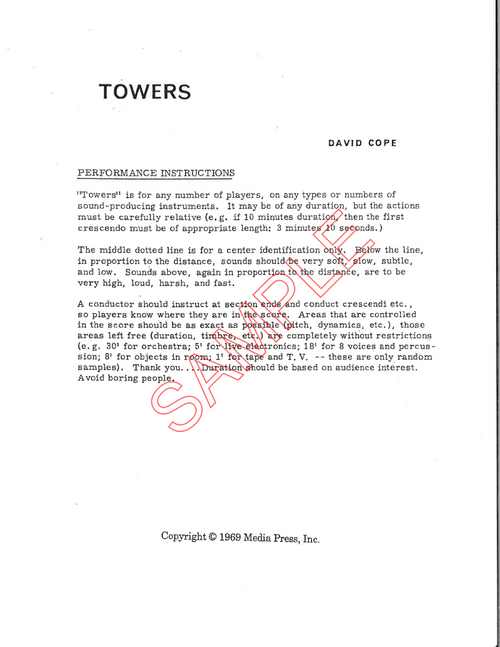For unspecified instrumental or vocal ensemble, includes score and instructions. The score to Hamm's Round is designed to be a continuous loop of music. Usually performed with a ring of music that turns so that as it passes each performer they play the music they see. As the ring of music turns faster, the work becomes more and more exciting. Duration: variable.
Print size: Legal (8.5 x 14")
Review from Percussive Notes (2022):
Composed in 1969 but recently published by Media Press Music, Charles Hamm’s “Round” presents a novel way for an unspecified ensemble of musicians to create a unique performance. Eight pages of music are included, which are to be attached around the edge of a circular ring to be mounted at eye-level. (Hamm suggests a timpani head as one possibility.) Each page includes a staff with unmetered eighth-note melodic fragments and sustains. No clefs are indicated. The musicians are instructed to stand in a circle around the ring and play each grouping of notes as quickly as possible in the clef appropriate for their instrument as it rotates and passes in front of them, creating a colorful and unique collage of sound.
Hamm seems permissive to any interpretive ideas performers wish to bring to the piece, but lists several ideas of his own, such as keeping the score stationary with performers on a revolving platform or walking around the score, putting the score on film with the appropriate time lag for each performer, using multiple scores on multiple wheels placed in various spots around the performing area, and having each performer’s part prerecorded and mixed with the others (with or without electronic distortion) with a time lag between parts.
A few logistical issues come to mind, such as determining how the ring will rotate (will a mechanical device be used or invented, or will an extra performer be needed to do the rotating?), whether the score will need to be enlarged or reduced to accommodate the ring (in the case of a timpani head being used), and how many players can be placed around the ring without overcrowding (increasing the score size and/or using multiple rings might address this).
None of the note groupings are especially difficult and would be playable by undergraduate college performers, given a conservative speed of rotation, making this a unique experience for collaboration between musicians of various disciplines. Certainly, the video and audio software now available on laptops would offer unique opportunities that did not exist when this piece was composed. This would allow performers or directors to take the presentation in even further reaching directions, and I think the composer would approve of such creativity.
—Jason Baker






![Henry, Otto- Omnibus [1], for unspecified pitched instruments (Digital Download) Henry, Otto- Omnibus [1], for unspecified pitched instruments (Digital Download)](https://cdn11.bigcommerce.com/s-m5busd93p5/images/stencil/500x659/products/351/693/Henry-_Omnibus_1_wm__01210.1543880060.png?c=2)
